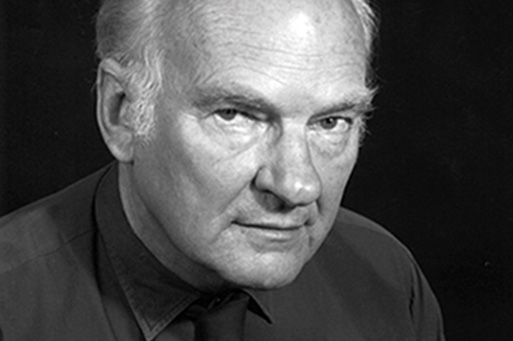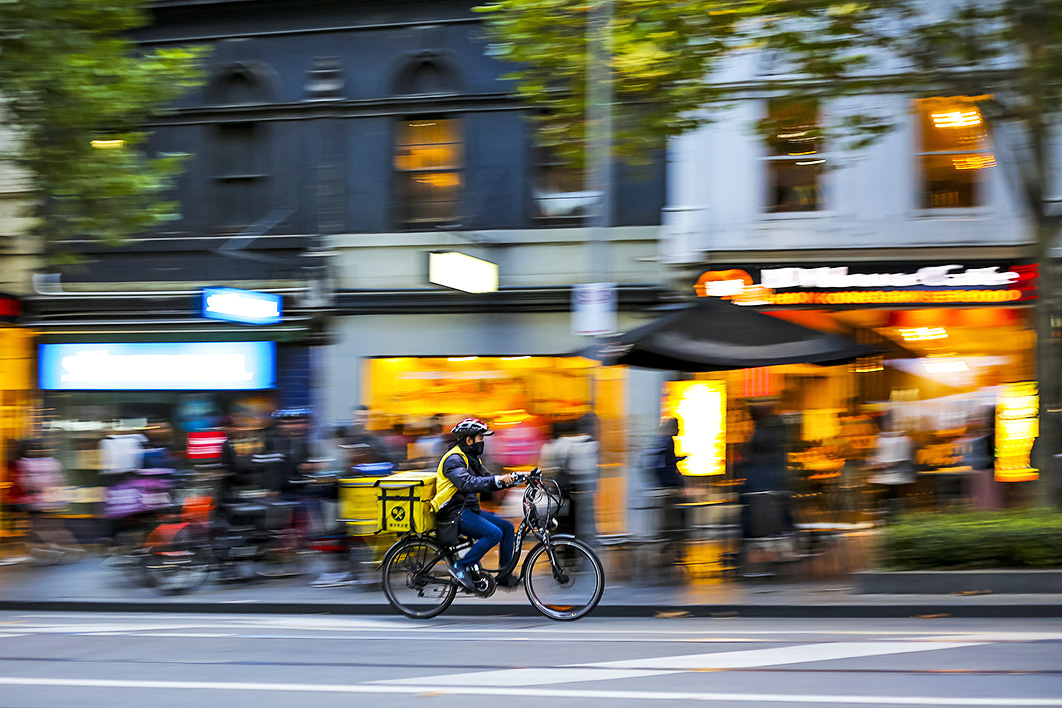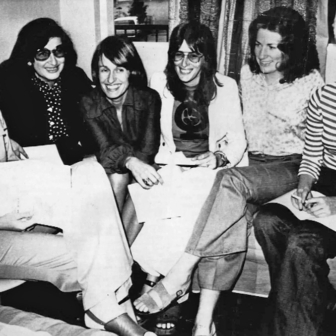It’s time to head to the airport. Bag packed, call the cab. Better make it an Uber — at least you know exactly when it’ll arrive. And your driver’s behaviour is being graded out of five stars, which I’ve found means the trip is more likely to be convivial. I often find myself deep in conversation with Uber drivers in a way that’s rare in a taxi. Perhaps we’re both performing for the algorithm, or at least feeling safer in the knowledge that each of us has a stake in the conversation going well.
I wait seven minutes before the car arrives. My driver this time is Australian-born, and we get chatting pretty quickly. I learn he’s driving Ubers on the side while doing his MBA. While we talk, we also negotiate with the digital map that lurks on the dashboard, giving us instructions on where to go. I have my own favourite routes through the local streets that get me to Sydney’s airport, but the map, fed by data obtained from all of us going about our daily business, has its own ideas.
I tell my driver about a photographer friend of mine, also an Uber driver on the side, who likes to run two versions of Google maps when he’s driving, one within the Uber app and one straight from Google. My friend says the Uber route is just slightly longer, and therefore more expensive, most of the time. That seems hard to be believe, my driver told me, but yeah, maybe.
My driver and I get to talking about Uber’s opening up to public shareholders earlier this year, which saw the company attract a lower sharemarket price than was anticipated, mostly because of revelations by the company that it was struggling to make a profit from ride-sharing. My driver was pretty well informed about all this. “For Uber, long term, it’s about the data, not the ride-sharing,” he explained to me, not knowing quite how obsessed I was with the company myself, and with the rise of data-driven urban platforms more generally. I nodded and agreed. Yep, it’s all about the data.
We’d probably been reading similar stories about Uber in the news recently. Dara Khosrowshahi, the chief executive, seems to be running a PR campaign about the company’s ambitions to become the “broker of human movement” — specifically, of “people, food, and freight” — in cities. Kind of like the Amazon of transportation, he has been saying. When it was first launched, Uber created a new marketplace for ride-sharing by better connecting people who needed a lift somewhere with people who could trade some, or most, of their spare time for extra money. Uber Eats, launched in 2012, has likewise provided a simple way for people to order takeaway food, by connecting these people with others in their city who would happily deliver it to them for a small fee without having to be tied to one particular restaurant. Uber Freight is coming too, an app that “matches carriers with shippers” in a way that presumably will aim to beat systems people use now to get their freight where it needs to be.
I wonder aloud, to my driver, what kind of “broker” of human movement Uber is. Is it really so “data-driven’? Isn’t this still, really, about human capital, and how it’s being put to use? Uber spends a lot of money on incentivising drivers, “shippers” and food deliverers to use its platform to generate their own income, perhaps swapping what they’re already doing for this gig, or perhaps squeezing it into their spare time to make some extra cash. The amount of money Uber spends on marketing and user incentives is why they don’t yet make money on their ride-sharing business, despite the considerable fees they charge drivers, food deliverers and restaurants to use the platform. Being big, being part of more and more urban interactions taking place across every city around the world, is what matters most here. I put it to my Uber driver: Isn’t that just classic rent-seeking behaviour?
The difference here is the data, he explains to me. He says “dayta,” like an American, not “darta” like most Australians. You can’t work in tech or business these days and get away with “darta.” Uber can make all kinds of uses of the dayta created by users — which means, he explains, their brokerage service is not non-productive, in that classic rent-seeking sense. They’ve accelerated into self-driving cars, and they can also use all that dayta they’re generating to capture a granular sense of how cities really work.
Yes yes, that dayta.
It’s one of those conversations that pokes around some big topics, but won’t jump fully in. My Uber driver and I know we’re only going to be speaking for a few more fleeting moments before I jump out of the car with a cheery goodbye, trying not to slam the door too hard lest I damage my rider rating. Good luck with everything! I say.
Once out of the car, the Uber app hits me with a rating request. How was your ride today? I enthusiastically tap on the five-star option, and choose “Great conversation” to describe why my trip was so great.
The experience I’ve just recounted is not quite true — it’s more an amalgam of many different Uber trips I’ve taken over the past few years, and the conversations I tend to strike up with drivers. During much of Uber’s life in Australian cities, I’ve been reflecting on how platforms of this kind have been affecting the way we live in cities together.
Despite all kinds of misgivings about the kind of company Uber is — a massive, US-based outfit that fleeces the very people it seeks to “partner” with to sell its technology, and puts taxi drivers like my neighbour out of a job — I’ve become fascinated by the kinds of interactions it and similar companies have introduced.
There’s a sense of heightened sociability between strangers that seems to occur, perhaps because we’re protected by that threat of algorithmic-generated banishment if either party takes a misstep. Or maybe it’s the kind of people who have been quick to take up Uber as a transport option. As an iconic company of the “gig economy,” Uber often attracts people who aren’t looking to drive cars for the rest of their lives — which means you get to chat with people like my Uber driver, who also happened to be studying for an MBA and thinking about the future of data platforms.
Uber is also, in many senses, the realisation of a quite radical idea advocated for many years by sustainability planners. What if we could get people to stop thinking of transport through the lens of the privately held motor vehicle and instead encourage people to share their driving experience? Couldn’t this cut the number of cars on the road, and free up space for other kinds of uses?
Like the car-sharing company GoGet, founded by sustainability advocate Bruce Jeffreys, Uber advocated its way into our cities as an innovative way to get people to move around them differently. Assets once considered purely private could become shared resources. Instead of ownership being the goal, we could reduce consumption and shift towards an economy based on access.
Apart from GoGet, these companies haven’t focused on creating cities that use fewer of the planet’s scarce resources. For Uber, creating a technology platform to improve human movement was more a way to grow a company quickly — really quickly, faster than any company before, generating huge benefits for its business leaders, investors, and shareholders.
For a company like Uber, the future of cities, and how we live in them, is primarily about the possibility that digital infrastructure built today will stick around as a foundational platform for future generations, in cities all around the world, to use as their first choice. Time to go to the airport? Better Uber it. Getting people around the world to use your company name as a verb to describe some of the most basic things we do in cities is, really, the ultimate, multi-billion-dollar goal. Want to know where you’re going? Better Google it.
Those who think about cities and digital innovation are often people like my Uber driver, busy coming up with start-up business ideas in this brave new world of tech-driven urban interaction. Many, it seems, focus their minds on new ways to do takeaway food. After all, people are time poor, but they also need to eat. Why not better service the needs of those who not only lack the time or wherewithal to cook, but would also prefer not to have to actually go fetch their order?
The success of digital food delivery apps has probably caught your attention. Australia is, it seems, becoming “an Uber Eats nation,” as one journalist puts it, with online food delivery services now worth 12 per cent of all sales in the $44 billion cafe, restaurant and takeaway food industry, and one in three adults living in Australian cities reporting use of food delivery apps.
No wonder, then, that moving around our major cities now seems to involve a lot of interaction with bike-riders carrying large square boxes of food to the time-poor customers. A relative of mine has told me that university campuses, like University of Sydney and UNSW, are hotspots for these delivery services, as many overseas students prefer the ease of using an app to order their lunches rather than having to negotiate campus food options.
Australian digital entrepreneurs are hoping to cash in on the trend. Two founders of a company called Kloopr have created an app that allows anyone travelling from point A to point B to become a delivery driver. Just think: you might be able to earn a bit of money on your way home, just by checking if one of your neighbours has ordered take-out. Others, like Bring Me Home, let you buy and pick up discounted surplus food from nearby cafes, restaurants, bakeries, groceries and supermarkets. This company is targeting Australia’s food waste problem in a way that’s also attractive to those who would prefer not to cook tonight or go out.
In other words, today’s digital platforms have made Australian cities attract spaces for disruptive new ideas about how to connect people differently. Most Australian citizens are now equipped with their own GPS receiver, bundled into the shiny, glowing, advanced computational device they carry around with them everywhere, otherwise known as the smartphone. On that phone are likely to be abundant maps, apps, recording devices, listening devices, maybe fitness trackers, maybe also air quality monitors. The phone many of us are carrying with us may also be listening to us in various kinds of ways — whether through the tiny microphones used to listen in on conversations (who knew?!), or by “listening” in the sense of analysing the information we churn through as we go about our daily business.
The translation of myriad kinds of urban interaction into data points for more sales is what attracts the brightest and the wealthiest to thinking about all kinds of new ideas for Australian cities. How can all this information be used to build new businesses, sell more, but also make our cities “smarter,” more responsive to infrastructural breakdowns, “closing the loop” between human interaction (or malfunction), infrastructure, services, and utilities?
Those people who come up with the best and brightest ideas for using data to make Australian cities work better are showered with investment money to help them scale as fast as possible. One such company, Neighbourlytics, offers “the data you need, to create cities people love.” Founded by two Australian women, this urban platform offers “simple ways to collect and understand rich digital data about what makes places thrive” by using social media data to capture community sentiment about a place. It’s particularly useful for real estate companies and city leaders who want to “see places through local’s eyes.”
Countless other digital platforms are also vying to change how we learn about, manage, govern, experience, connect and interact with each other in cities. For each, it is the data — the dayta — that drives innovation and new ideas about Australian cities. If data is the new oil, cities are the new goldmines, ripe for data-mining machine-learning, behavioural nudging and, ultimately, value-extraction.
Many who work in urban tech these days tend to think the possibilities offered by information technology are quite new. This, like my Uber story, is only partially true. Certainly, all the computational innovations that underpin our digitally mediated experience of cities today are new. But, at the same time, this way of seeing cities has its own peculiar history. In previous decades, it was spurred on by ideas from cybernetics, emboldened by the potential of clever “counting machines” to decode the complex webs of interaction that make up a city.

Will lots of things be missed? Historian Hugh Stretton. University of Adelaide
Despite their novel techniques, many urbanists railed against these computer-mediated visions, not because they weren’t passionate about better understanding complex urban problems, but because they worried what kind of city this way of seeing would bring into focus.
One such worrier was the Australian urbanist and historian Hugh Stretton. Paying close attention to the relationships between urban form, urban marketplaces and diverse urban sociality, Stretton was ambivalent about the use of “information” as a lens through which to understand Australian cities. In his 1970 book Ideas for Australian Cities, now half a century old, he reflected on what he described as a kind of urban “ideology” that looked to create objective measures of urbanity to plan and manage Australian cities. He wrote:
What are cities, essentially? They are systems of intense, hyper-efficient interaction. Interaction is quintessentially the transmission, reception and exchange of information. The basic unit of information is the simple clause or image, the “bit.” The basic unit of interaction is the transmission of one bit from one human to another. Call this basic transaction a “hubit.” Private, face-to-face hubits are not countable. But the public channels of communication are all metered, one way or another. Count the hubits they carry. Weight them for distance carried. Divide by time and population, and you have indexed the intensity of interaction. Indeed, you are on the way to a universal, abstract and reliable measure of urbanity, and a general theory of it. You also have a political program: to maximise urbanity.
Stretton saw problems in this way of seeing cities. It proposed that they could best be understood through the lens of science, specifically “systems analyses” that used mathematical methods to understand and manage things like traffic flows. These were fine, in some instances, but shouldn’t be used as the basis from which to understand other things about cities. The risk, as Stretton saw it, was that only some things would get counted. If cities are intense interaction systems, the kinds of interactions we would pay most attention to might end up being those that could be counted most easily. Lots of things might be left out:
Making love is an interaction; so is a business deal or a visit to the doctor or a sparkling conversation about art in somebody’s salon; so is every jostle on a crowded pavement, every bit of unwanted commercial soliciting, every exchange of complaints about the noise or pollution or segregation of the city; so is every eviction, extortion, blackmail threat, sale of dope, or crime of violence in the city.
In this way, as Stretton put it, “Objectivity begets its own politics.” Certain kinds of interaction may grab most of the attention, simply because they can be counted, and the counting of them becomes beneficial to some parts of society, but not others. So, to Stretton, here was the basis of a political program: “to maximise urbanity.”
To many of today’s urbanists, who look to the potentials of “smart cities” and data-driven methods of managing infrastructure and service provision, Hugh Stretton’s cantankerous views might feel a bit old-fashioned. Certainly, Ideas for Australian Cities is not easy to find (I had to borrow my father’s copy in order to re-read it for its coming anniversary). His reflections on information and urban science, in a chapter called “Ideology,” are tucked away in chapter six, after a series of quite quotidian reflections on the strengths of mid-sized Australian cities like Adelaide and Canberra.
And yet, re-reading his critical reflections on what we might call urban informationism today, Stretton’s writing feels urgent, and altogether necessary. With a wave of urban apps hitting the streets, encouraging us to stay home, watch Netflix, stay away from restaurants, and keep swiping, we’d do well to remember that all this data we’re producing, through our myriad ways of interacting digitally, may benefit particular ways of being “urban.”
Even if they are mightily convenient, these services may, in the end, not be in our best interests. During these years I’ve spent observing and writing about this new wave of “urban apptivism,” I’ve noticed how many of the best, most responsive digital platforms are those built by technology companies that have access to very large amounts of user interaction data. And they like certain kinds of interaction over others.
Take Uber. Over fourteen million trips occur on Uber’s platform each day, by people like me and my MBA student, who Uber counts as a “driver partner” of the company, a “micro-entrepreneur” out to hustle. Uber likes our transaction to be considered a mutually beneficial transaction between two individuals in a marketplace — not a service delivered by a global multinational company. The user experience Uber offers us is also unparalleled among Australian taxi apps — no surprise, considering the $22 billion in investor finance ploughed into Uber over the past decade.
As Uber extends its muscle into the hospitality business, Australian restauranteurs are now experiencing something akin to what Australian news media outlets have gone through, in the wake of Google and Facebook, recently the subject of the Australian Competition and Consumer Commission’s digital platforms inquiry. They are finding their capacity to reach customers increasingly depends on nifty apps, which have figured out how to connect buyers and sellers, or readers and writers, in highly location-aware, responsive and “human-centred” ways.
With teams of global developers working to ensure the best user-interaction experience possible, it’s not surprising Australians love these apps. An ex-Google employee compares them to casino slot machines. With all this swiping going on, the data exhaust of our urban lives can in turn be ploughed into creating new, cleverer ways of interacting with each other. Like Stretton said: this is a program to “maximise urbanity” — except it’s an urbanity that amplifies the intelligence of machine-learning systems but doesn’t care much about our high streets, so long as we’re all interacting.
When I re-read Stretton today, I can’t help but wonder: who is championing our cities with these ideas in mind? His Ideas for Australian Cities influenced a generation of urban planners and policy-makers, including people like Tom Uren, who led bold interventions on behalf of the federal government to protect and champion particular mixed-use precincts in cities like Sydney, Fremantle and Hobart. This wasn’t anti-development, it was strategic intervention to protect what worked best.
Today’s cities likewise need a strategic government intervention to better shape their data infrastructures. Specifically, we need a new deal on city data, to ensure urban digital innovation doesn’t also mean digital feudalism.
And if Australian cities are going to be hotbeds of data-driven innovation, we would do well to remember Stretton’s cautionary words. To remember to cherish that which can’t be counted as possibly among the very best things that make our places thrive. •
Funding for this article from the Copyright Agency Limited’s Cultural Fund is gratefully acknowledged.





